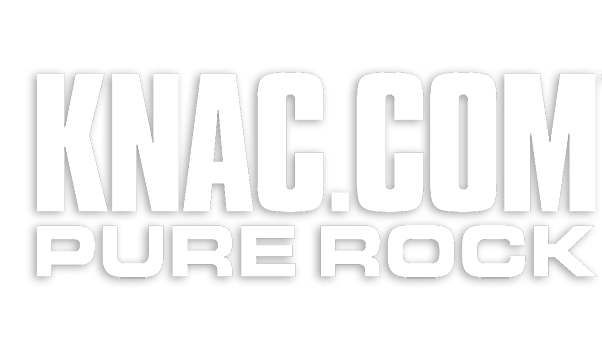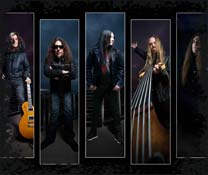Caught In A Dream: A Dream Theater Exclusive Interview
By
Robert Kreutzer,
Contributor
Monday, January 7, 2002 @ 1:54 PM
| Dream Theater Axe-Grinder John
|
 |
|
Dream Theater proves that art cannot only be fun but it can blow out your speakers, too.
Where too much of the metal/hard rock gaggle serves up radio-friendly bits of sameness that lasts no longer than a fast-food radio spot on one of the gazillion "X" or "power" radio stations dotting the dial, Dream Theater proves that hard rock can be downright high-falutin'.
OK, the idea of combining rock with classical music and, in Dream Theater's case, jazz, is nothing new, and the band has never been bashful about naming the likes of Yes, Pink Floyd and Rush as sources of inspiration. But where those bands got a little too artsy fartsy for their -- or our -- own good, Dream Theater manages to have their art and rock it, too. According to John Petrucci, who handles the axe duties for the band, attitude saves the band from the snooty tedium to which art-rock has too often drifted.
"It's not just a matter of gluing a bunch of complicated riffs together," explained Petrucci, on the telephone from a studio in New York. "It's a matter of making a song that's a good piece of music."
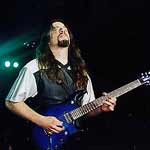 "As songwriters, it has always been very much an effort of ours to write good music, regardless of style, or how long the songs are," explained Petrucci, taking time out from a recording session for an upcoming solo project. "We wanted the messages to be good, the melodies to be good, and just for the songs to stand on their own. We also want it to be heavy, not too wimpy. As long as we keep a focus on that, we'll be able to keep putting out quality music."
"As songwriters, it has always been very much an effort of ours to write good music, regardless of style, or how long the songs are," explained Petrucci, taking time out from a recording session for an upcoming solo project. "We wanted the messages to be good, the melodies to be good, and just for the songs to stand on their own. We also want it to be heavy, not too wimpy. As long as we keep a focus on that, we'll be able to keep putting out quality music."
Quality is no short supply on Dream Theater's upcoming Elektra records release, Six Degrees of Inner Turbulence, a double CD slated to hit the streets in late January, with a tour to follow soon thereafter. The other players in Dream Theater are singer James Labrie, bassist John Myung, drummer Mike Portnoy and keyboardist Jordan Ruddess.
An FM or MTV hit ditty is clearly the furthest thing from the band's mind, as most of the songs on the disc one check in somewhere near the 10-minute mark. Stretched-out solos from Petrucci and Rudess bear the influence not only of classical music but also branch out into bebop-like spells, reflecting the band members' jazzy inclinations. Slight hip hop touches also tint things just a teeny a bit.
The second CD is the 42-minute title track, a tale of mental instability divvied up into eight movements ranging from straight philharmonic interludes and runs of almost pure jazz. Think John Coltrane's "A Love Supreme" meets Guns 'n Roses Appetite for Destruction with some Chopin and Yes' "Closer to the Edge" thrown in.
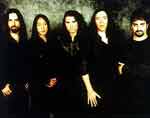 While some things are extended further than they really should be, listening to the CD is anything but a nightmare. All in all, it is the band's most ambitious undertaking to date, and Petrucci said the band standing pat wasn't really an option.
While some things are extended further than they really should be, listening to the CD is anything but a nightmare. All in all, it is the band's most ambitious undertaking to date, and Petrucci said the band standing pat wasn't really an option.
"The last album we did (1999's Scenes From a Memory) was a concept album, which is a pretty big undertaking," said Petrucci by telephone from a studio in New York, taking a break from recording music for a solo project. "After that, we were kinda like, 'what can we do now?' We didn't want to do just a collection of songs. We wanted to do something a little different."
| "It's not just a matter of gluing a bunch of complicated riffs together," explained Petrucci, on the telephone from a studio in New York. "It's a matter of making a song that's a good piece of music." |
|
A strong emphasis by band members on musicianship was natural, as they hooked up as students at the prestigious Berklee School of Music in Boston in 1985. Despite those credentials, aside from some ethereal keyboard runs the sound wasn't too far removed from the 1980s mousse-and-spandex standard.
Dream Theater released one album for MCA records in 1989 which established for them a healthy cult following but didn't much dent the charts. Some accounts say that the label dropped the band, but Petrucci said it was the band's idea to move on.
Finding a home with EastWest Records, the band began to hit its stride. The 1992 release, "Images and Words" went gold and yielded MTV hits like "Pull Me Under" and "Another Day" and is still regarded by some as Dream Theater's best. The band, though making adjustments in its lineup, would put out a series of well-received albums through the '90s.
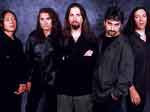 The 1999 concept CD Scenes From A Memory, proved a breakthrough for the band. The creative signatures and all-around musicianship once and for all cemented the band's credentials as a technical force to be reckoned with, but also saw the band thud at its balls-out rockin' best and the lyrics, weaving a flowing tale of mental imbalance, proved the band could tell a good story, too. According to Petrucci, the arrival of Ruddes helped the band show what it was really made of.
The 1999 concept CD Scenes From A Memory, proved a breakthrough for the band. The creative signatures and all-around musicianship once and for all cemented the band's credentials as a technical force to be reckoned with, but also saw the band thud at its balls-out rockin' best and the lyrics, weaving a flowing tale of mental imbalance, proved the band could tell a good story, too. According to Petrucci, the arrival of Ruddes helped the band show what it was really made of.
"Once he joined the band, it was like we found the missing link," Petrucci recalled. "I felt like the first album he did with us was only the beginning. I thought we would be writing our best music ever."
The CD was a favorite both with critics and fans. More important than the many props they garnered, though, came the confidence-- and with that, the liberation - the band to needed to finally dicate the terms in which it made its music.
| "Psychology, the mind, religion, these are the things that make you think deeply. This helps us create lyrics that are interesting, that help us decide what words to use and what kinds of imagery we create." |
|
"Before Scenes, before we even went to the studio, we would bring in demos to the record company, we had them listen to the songs, and then we'd pick a producer. For 'Scenes,' we didn't have an outside producer, we didn't show the label any songs and we didn't do any demos. We just went into the studio and did everything ourselves."
"It ended up being really successful. It showed what we were capable of doing, and that we knew our own audience and our own style better than anyone."
Unlike most bands built on instrumental virtuosity, Dream Theater takes lyrics just as seriously. Where many prog-rock bands' lyrics sound like a speech at a vegetarian poet meeting, politics, religion and especially psychology figure heavy in Dream Theater's written lines. While not a concept album in the strictest sense of the word, the songs do have a natural flow almost suggesting a story.
"Psychology, the mind, religion, these are the things that make you think deeply," said Petrucci. "This helps us create lyrics that are interesting, that help us decide what words to use and what kinds of imagery we create."
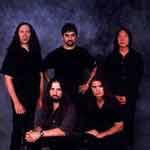 A few months ago, the band found itself to be prophetic in ways they would have preferred not to be. The live CD, Live Scenes From New York, was released September 10th, with cover art depicting the NYC skyline in flames. With the terrorist attacks the following day, the band wasted no time in asking the CD be pulled from the shelves to be given a new cover.
A few months ago, the band found itself to be prophetic in ways they would have preferred not to be. The live CD, Live Scenes From New York, was released September 10th, with cover art depicting the NYC skyline in flames. With the terrorist attacks the following day, the band wasted no time in asking the CD be pulled from the shelves to be given a new cover.
"With what was happening in the world," said Petrucci, "this thing was a matter of 'we're just not comfortable with this. We need to pull the CD and change the artwork."
Most of the band members also record a fair number of solo projects. Petrucci assured that these serve needs and purposes completely aside from Dream Theater and pose no threat to band unity.

|
